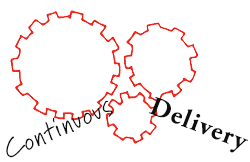Drawing on over 15 years of experience in the professionalisation of IT departments, Eugene Wolf, Director at Logicalis SMC, looks at the benefits and challenges associated with the adoption of a Continuous Delivery model.
DevOps; the final IT-frontier. In a time where speed is a strong competitive weapon it is time to explore that frontier… and cross it. We have the means and technology to really integrate Development and Operations and facilitate flawless continuous delivery, but do you have the nerve to radically change your way of working?
The advantages are clear, but it’s not a change that can be made overnight.
Assembly line
Continuous Delivery is about the automation of your entire deployment process, from code-changing by the developer, to testing and the final release go-live at the operational level – just like in a well-oiled assembly line.
The basic idea of Continuous Delivery is simple: take small, controlled steps and deliver incremental changes on a continuous basis. That sounds easy but the real challenge here is to bridge the gap between Development and Operations, because the success of Continuous Delivery is based on ONE smooth process that encompasses development and roll out.
So it is essential that the two separate worlds – Development and Operations – together define the best possible automated delivery pipeline. As an added bonus, while learning from each other’s processes, they improve transparency, understanding and cooperation.
Repeatable processes
By automating all processes together, Continuous Delivery lowers risks and reduces the capacity for error in the delivery process. Once you have it in place you can focus on what you deliver, rather than how, because the automated, repeatable processes make sure the quality of delivery is under control.
Even security improves with Continuous Delivery since it leaves no room for free interpretation; it guarantees the correct use of components and ensures that all responsibilities are managed from one centralised administration point.
Controlled steps
Continuous Delivery, then, can deliver significant, and achievable, benefits. All the same, it is only fair to honestly look at the other side of the coin - implementation.
Implementing a Continuous Delivery model clearly means more than simply bringing in some tools for Release Automation. No matter how good those tools are, this is a transformation in which people are the key for to success. It’s worth emphasising this point - your professionals, from Development and Operations, will truly have to work together. And that probably requires a cultural change, with new roles and new processes for everyone in IT.
So, if you are planning for Continuous Delivery, don’t just focus on the technical side. Remember your team; train them, make them work as one team and involve them in the turnaround so they feel committed and responsible. Only with this ‘people element’ of change implemented effectively can you truly realise the benefits of Continuous Delivery.
The message, then, is simple. Underestimate neither the advantages of Continuous Delivery, nor the effort it takes to implement it. A realistic view is always the best start.
For more information about Continuous Delivery and how it can help your organisation deploy fast, continuous, new and better releases with fewer mistakes click here.

